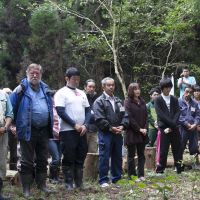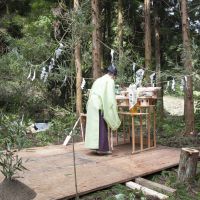On Oct. 6, 2012, I took part in a Ji-chin-sai (Shinto ground-breaking ceremony) in the Nobiru area of Higashi Matsushima City in Miyagi Prefecture. Standing with me before an altar constructed in a wooded part of the Omokura Valley was Takahashi Yuugo, a volunteer who had been cutting trees and making steps down a steep slope to the site, and Sato Shinji, the city official in charge of rebuilding and revitalizing the area in the wake of the Great East Japan Earthquake of March 11, 2011, and the giant tsunami it triggered.
Saddened, moved and deeply concerned about the people of that area, our Afan Woodland Trust invited folk who had been traumatized by the terrible destruction and loss of life to spend a few relaxing days and evenings in and around our woods in the Kurohime hills of Nagano Prefecture.
After those of its citizens had partaken of our "green medicine," the city then asked us to help them relocate and rebuild a primary school in some densely forested hills right by the worst-hit area of Nobiru.
The school needed to be rebuilt on safer, higher ground, but people were pessimistic about using the hillside woods because they were so dense and dark and overcrowded. That was until they saw our Afan woods — and photographs of how dense and dark and overcrowded they had been back in the 1980s. Realizing what a transformation was possible turned their pessimism on its head, as they could suddenly see a brighter future.
We surveyed the Higashi Matsushima hills, valleys and woods and found 11 species of rare and endangered plants — as well as an old hillside road along which horses had once hauled timber and masonry.
We'd soon found, too, that the area was home to hares, squirrels, racoon dogs, foxes and other animals, and was rich in birdlife.
Further research then revealed that people had inhabited these hills since back in the prehistoric time of the Jomon pottery culture (8000 B.C.-300 B.C.). The valleys were sheltered from typhoons and winter winds, and had lots of springs and small streams that encouraged the building of rice paddies and ponds to hold the water.
On the land obtained by the city for the new school and other facilities — including a hospital, kindergarten and a home for the elderly — many of the paddies had been planted with sugi (Cryptomeria, aka Japanese cedars). These have not been tended and are crowded, dark and strangled with vines, and the ground beneath the trees is boggy and brown.
Kingfishers breed near the old ponds, and ospreys prey on the alien black bass that had been released into them. The ponds were also visited by ducks, cormorants and other water birds, especially when there were storms at sea.
Right from the start, I clearly stated that if the plan was to clear the forest, bulldoze the hills and fill the valleys in order to build a ferro-concrete box, then there was nothing we could do to help.
Of course access roads, sewerage and water pipes and power supplies would be needed, but if the Afan Trust was to be involved then the scenery, ecology and natural life would at all times have to be considered, and the most sensitive areas protected. If we put hearts and minds together, though, we can not only protect nature — we can enhance it.
We insist that the school buildings be built of wood, including the light, strong and durable modern forest products such as laminated beams and pillars that really are stronger than their equivalent weight in steel and which will resist fires without buckling. Properly built wooden buildings are also very resistant to earthquakes and are healthier and easier on children with allergies and so on.
The classrooms should look out onto natural scenery — trees, ponds, renewed paddies and streams — with pleasant walkways between buildings. We are bringing together some of the best experts in Japan and have already held meetings, seminars, events and discussions.
As well, we have gone around the area's schools, and have invited both children and adults to our woods and our new and superb Afan Trust Centre. Over the last 14 months, we have gained support from the mayor of Higashi Matsushima City and from local and prefectural officials responsible for town planning and education. And all that's as well as the support forthcoming from local people, non-governmental organizations, corporations, construction and environmental experts, artists, educators and individuals from all walks of life nationwide.
And, I'm delighted to say, there are some Tohoku horse-loggers who are eager to be involved, both in helping to extract the logs from trees that must be trimmed out, and by bringing working horses back to the community.
Of course, we do have opponents — generally ones of a type that doesn't like to come out into the open. They're mostly die-hard construction officials who love concrete, and a few politicians reared on a diet of kickbacks, who, like the wild racoon dogs in the hills, always seem to crap in the same places.
It will probably take three or four years before the dickering is over and the school is finally built, so in the meantime we will create facilities, such as a tree house and campground, where we can have special classes for those children who will have graduated from their temporary schools before the main forest school is finished. We want them to feel that they are involved in the whole project. The reaction has been very enthusiastic.
After the Shinto ceremony, our staff, together with volunteers both local and from outside, began clearing brush. We also needed to start trimming out those dense plantations of cedars planted on old paddies.
From the boggy terrain, and by confirming through dousing with a willow wand, I was sure that a stream had formerly run down the valley we had begun working on. Then that evening, some old folk said they remembered how long ago there had indeed been a clear running stream here — and people used to wash their horses in it. We will bring back that stream, clear the connecting ponds of excess mud and garbage, and lower the level of groundwater to give the surrounding trees a better chance to grow healthy roots.
Ken Hachimaru and Takashi Iwama, together with Dai, a 22-year-old gelding, gave a masterly exhibition of how a skilled handler and a horse can efficiently extract logs out of difficult terrain with little if any damage to the environment.
In the evening we enjoyed an excellent barbecue, lots of fun, laughter and earnest planning for the future around the open fire. The children who took part made heaps of discoveries: They found a praying mantis, lots of frogs, including a very rare species, fish in a stream, racoon dog tracks, wild hops and akebi (chocolate vine) fruits with their sweet seeds.
We brought children's laughter back to the woods. Our forest school has started.




















With your current subscription plan you can comment on stories. However, before writing your first comment, please create a display name in the Profile section of your subscriber account page.